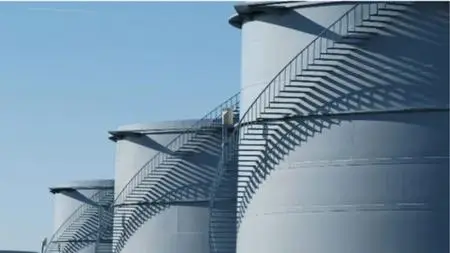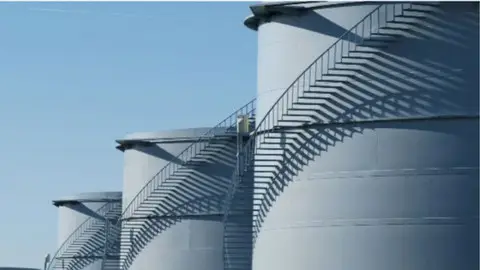Oil And Gas Industry : Tank, Sphere & Bullet Specification
Last updated 8/2022
MP4 | Video: h264, 1280x720 | Audio: AAC, 44.1 KHz
Language: English | Size: 4.43 GB | Duration: 4h 48m
Last updated 8/2022
MP4 | Video: h264, 1280x720 | Audio: AAC, 44.1 KHz
Language: English | Size: 4.43 GB | Duration: 4h 48m
Know how & why for API Aboveground Storage Tanks, Sphere & Bullet storing Petroleum, Refinery, Chemical, Petrochemical
What you'll learn
Learn different ways of aboveground tank classification
Tank Type Selection Criteria
Tank Sizing Criteria
Critical Aspects of Tank Specification
The International Codes that govern the specification to fabrication of Aboveground Tanks focussed on the Specification Aspects
The Critical Tank Connections
Solved Examples of Tank Sizing, Selection and Specfication
Requirements
Any one working in Chemical, Petrochemical, Refining, Oil & Gas Industry
Anyone dealing with Aboveground Storage Tanks
Aspiring Professionals about to complete Mechanical and chemical engineering diploma or degree
Description
In Chemical plants, storage tanks, sphere and bullets are ubiquitous.Any Chemical, Petrochemical, Refinery, Oil & Gas, Pharmaceutical facility and for that matter any facility burning fuel or treating waste water will have tanks. It may have either sphere or bullet depending on whether LPG, Propane or Ammonia is processed.Since it is commonly present, the knowledge of selecting, sizing and specifying tanks, sphere and bullet is taken for granted. However, this is not the case.When I started work in the petrochemical Industry about 30+ years back in a Tank farm being constructed, there were no manuals, books or procedures. There was no access to any standards. None of the experienced seniors were willing to teach, coach or mentor. When I moved a EPC firm, the same problem continued.Now, we are in a different era. Every information is available at our fingertips. But the students suffer from excess information which brings in a lack of focus.This course aims to equip the students to with sufficient knowledge to be able to select, size, specify and review process design with confidence. The aim is to set the students on the path to gain excellence in the subject.The course has lectures, examples and activities to help the students to understand and apply the concepts. (August 2022)Currently, there are 16 examples , 6 activities, quizzes and worked out assignments for ensuring hands on skill development. (August 2022)WHAT THE COURSE IS NOT ABOUTThis course is NOT about Design, Fabrication, Inspection, Installation or Detailed Engineering of chemical storage and its associated piping, instruments and electrical items. However, points can be discussed in the Q & A section.The students would benefit from interacting with an experienced professional who is keen to share the knowledge and experience to benefit the future generation.Get Started Now. Click the "Take This Course" Button in the upper right to enroll.The topics covered are as follows:Classification of TanksBased on Service, Internal Pressure, Roofs & Bottoms Tank Selection CriteriaVapor Pressure, Flash Point & Flammable LimitsFlammable Fluid ClassificationTank Sizing CriteriaAPI 2350 overfill protection for TanksTank Height Determination Tank Automation and Controls (Apr 22 Addition)Factors affecting Tank Type Selection (July 2022)Effect of Temperature on Tank Type Selection (July 2022)Effect of Vapor Pressure on Tank Type Selection (July 2022)Effect of AIT on Tank Type Selection (July 2022)Effect of Flash Point on Tank Type Selection (July 2022)NFPA based Tank Type Selection Matrix (July 2022)Vapor Pressure based Tank Type Selection Matrix (July 2022)Nitrogen Blanketing (July 2022)Tank Type Selection Summary (July 2022)Static Electricity and Tank Selection 9 Examples of Tank Selection (July 2022)4 Example of Tank Sizing (July 2022)Applicable Codes and StandardsAPI650API620BS EN 14015Venting CausesEmergency Venting optionsOpen VentsPressure Vacuum Relief ValvesPilot Operated Vent ValvesEmergency HatchGauge HatchTank Connections & AppurtenancesTank SealsFrangible RoofTank Gauging (Brief)Temperature InstrumentsWater Draw-off SumpTank Mixing Equipment (Brief)Flexible Piping Systems for Roof Drain and Oil Skimming SystemFoundations (May '22 addition)Tank foundationTank ShellTank BottomStaircase & Walkway Tank SpecificationEngineering Work Process for “Tank Pre-Order” Specification development Development of Process Datasheet for an External Floating Roof TankAPI 650 Clauses that Purchaser needs to specify LPG Sphere and Bullet (July 2022)General Rule for Storage Type SelectionPressurized Storage typesLPG PropertiesLPG HazardsDeciding on Aboveground vs Mounded LPG StorageWhy Mounded Bullets?Bullet Vs SphereWorking Capacity of Sphere & BulletOperating & Design Temperature of a SphereOperating and Design Pressure of Sphere & BulletSphere FittingsSphere Bottom ConnectionSphere Level gaugingSphere Pressure reliefSphere Relief valve installationSphere Shutoff valvesSphere Emergency shutoff valvesSphere Layout principlesSphere Drain, insulation and icing in valvesQuizzesAssignmentActivities (August 2022)Relevant Youtube Videos & Documents more to be addedUdemy Certificate on completion You will also get a one to one interaction with the industry veteran instructor on the topic.Get Started Now. Click the "Take This Course" Button in the upper right to enroll.
Overview
Section 1: Introduction
Lecture 1 Introduction to the Course
Section 2: Tank Classification
Lecture 2 Tank Classification by Service
Lecture 3 Activity- Identify Tank Service using attached datasheet or student's database
Lecture 4 Tank Classification By Internal Pressure
Lecture 5 Activity : Classify tank by Internal Pressure
Lecture 6 Tank Classification By Roof -Fixed Roof
Lecture 7 More About Cone Roof Types
Lecture 8 Floating Roof, Internal Floating Roof & Dome Roof Tanks
Lecture 9 Tank Classification based on Tank Bottoms Type
Lecture 10 Activity : Classify Tank by Roof type and Bottom Type
Section 3: Tank Type Selection
Lecture 11 Factors Affecting Tank Type Selection
Lecture 12 Effect of Temperature on Tank Type Selection
Lecture 13 Effect of Vapor Pressure on Tank Type Selection
Lecture 14 Autoignition temperature
Lecture 15 Effect of Flash Point on Storage tank type
Lecture 16 Inter-relationship between Flash Point, LFL, AIT
Lecture 17 Activity : Identify Tank Fluid Properties
Lecture 18 NFPA classification based Storage tank type selection
Lecture 19 Vapor Pressure based Storage Tank Type Selection
Lecture 20 Activity: Identify Preferred tank type based on Vapor Pressure and Flash Point
Lecture 21 Nitrogen Blanketting Requirement
Lecture 22 Tank Selection Basis Summary
Lecture 23 How Static Electricity impacts Tank Type Selection?
Lecture 24 Activity : Identify tank Diameter & Volume and Remarks if any
Section 4: Examples of Tank Type Selection
Lecture 25 Example 1: Acetic Acid Tank Type Selection
Lecture 26 Example 2: Acetic Acid Tank Type Selection
Lecture 27 Example 3: Acetone Tank Type Selection
Lecture 28 Example 4: Acetone Tank Type Selection
Lecture 29 Example 5: Paraxylene Tank Type Selection
Lecture 30 Example 6: Toluene Tank Type Selection
Lecture 31 Example 7: HSD Tank Type Selection
Lecture 32 Example 8: MEG Tank Type Selection
Lecture 33 Example 9: TEG Tank Type Selection
Section 5: Tank Sizing
Lecture 34 Tank Sizing for different types of tanks
Lecture 35 API 2350 Overfill Protection For Tanks
Lecture 36 Tank Height Determination
Lecture 37 Tank Automation & Control System
Section 6: Tank Sizing Examples
Lecture 38 Example 10: Acetic Acid Tank Sizing
Lecture 39 Example 11: Acetone Tank Sizing
Lecture 40 Example 12: Paraxylene Tank Sizing
Lecture 41 Example 13: MEG Tank Sizing
Section 7: Applicable Codes and Standards
Lecture 42 Applicable Codes and Standards
Section 8: Venting
Lecture 43 Causes of Venting
Lecture 44 Venting - Floating Roof Tanks
Lecture 45 Emergency Venting options in Tanks
Lecture 46 Different Tank Protection Devices
Lecture 47 Open Vents
Lecture 48 Venting - Direct Acting Valve Types
Lecture 49 Description of Direct Acting Valves
Lecture 50 More on Direct Acting Valves
Lecture 51 Pilot Operated Vent Valves
Lecture 52 Pressure/Vacuum Relief Valves Settings
Lecture 53 Emergency Manway / Hatch
Section 9: Tank Connections and Accessories
Lecture 54 Floating Roof Tank Seals
Lecture 55 Frangible Roof
Lecture 56 Gauge Hatch
Lecture 57 Tank Gauging
Lecture 58 Temperature Instruments
Lecture 59 Water Draw-off Sump
Lecture 60 Tank Mixing Equipment
Lecture 61 Flexible Piping Systems in Tanks for Roof Drain and Skimmer
Section 10: Foundation, Shell, Bottom, Staircase, Stairways
Lecture 62 Tank Foundation
Lecture 63 Tank Bottom
Lecture 64 Tank Shell
Lecture 65 Staircase & Stairways
Section 11: Tank Specification
Lecture 66 Engineering Work Process for Tank Pre-Order work Process
Lecture 67 Tank Specification
Lecture 68 Example 14: Floating Roof Tank Process Datasheet Preparation
Lecture 69 API 650 Clauses that require Purchaser Inputs
Section 12: LPG Sphere and Bullet
Lecture 70 General Rule for Storage Type Selection
Lecture 71 Pressurized Storage types
Lecture 72 LPG Properties
Lecture 73 LPG Hazards
Lecture 74 Process Safety Incident involving BLEVE
Lecture 75 Deciding on Aboveground vs Mounded LPG Storage
Lecture 76 Why Mounded Bullets?
Lecture 77 Bullet Vs Sphere
Lecture 78 Working Capacity of Sphere & Bullet
Lecture 79 Example : LPG Tank Sizing
Lecture 80 Operating & Design Temperature of a Sphere
Lecture 81 Example : Calculation of Minimum Design Metal Temperature
Lecture 82 Operating and Design Pressure of Sphere & Bullet
Lecture 83 Sphere Fittings
Lecture 84 Sphere Bottom Connection
Lecture 85 Sphere Level gauging
Lecture 86 Sphere Pressure relief
Lecture 87 Sphere Relief valve installation
Lecture 88 Sphere Shutoff valves
Lecture 89 Sphere Emergency shutoff valves
Lecture 90 Excess Flow Check Valves
Lecture 91 Sphere Layout principles
Lecture 92 Sphere Drain, insulation and icing in valves
Lecture 93 Mounded LPG Storage
Lecture 94 Inherent Safety Aspects of Mounded Storage
Lecture 95 Instrumentation on Mounded Bullets
Section 13: Bonus Coupon
Lecture 96 Bonus Coupon for new course
Young Engineers in EPC Contractor environment,Currently Plant Operations or Technical Services folks aspiring to make a career transition to EPC contractor environment,Young Tank Fabrication Company Professionals,Young Engineers aspiring to work in an EPC contractor environment,Tank Farm Operations and Maintenance Professionals



